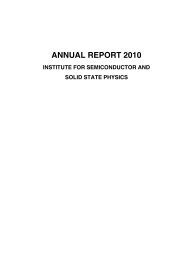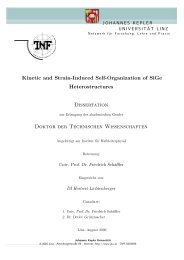Diplomarbeit Diplom-Ingenieur - Institut für Halbleiter
Diplomarbeit Diplom-Ingenieur - Institut für Halbleiter
Diplomarbeit Diplom-Ingenieur - Institut für Halbleiter
Create successful ePaper yourself
Turn your PDF publications into a flip-book with our unique Google optimized e-Paper software.
30<br />
For the JEM 2011 FasTEM with a Cs of 1mm and 200keV electrons with a λ of<br />
2.5·10 -2 Å this equation leads to a resolution of 2.3 Å which is equal to the specified<br />
resolution by JEOL [35].<br />
3.5 Sample Preparation<br />
The aim of sample preparation is the production of thin enough samples. Electrons<br />
can only pass through samples thinner than about 100nm. For HRTEM imaging, the<br />
sample must be even thinner and should be only a few nanometers thick if it should be<br />
simple to interpret the images. The sample holder of the Jeol JEM2011 FastTem<br />
requires samples with a diameter of 3mm. These small disks are thinned to the<br />
necessary thickness. For a detailed description of the Sample Preparation see [40].<br />
One distinguishes between two kinds of preparations concerning the direction of<br />
view with respect to the layer structure of the specimen. With a cross sectional sample<br />
(X-specimen) one looks along a direction in the plane with the layer of interest. With<br />
a plan view (P-specimen) sample one looks along a direction perpendicular to the<br />
layer. The material is cut with a wire saw or an ultrasonic cutting device [37]. After<br />
the fabrication of the blank shape (for our sample holder a disk with a diameter of<br />
3mm), it is thinned by grinding on a rotation wheel to about 150 μm. The next step is<br />
done with the so called dimple grinder [38]. A rotating wheel grinds a dimple in the<br />
middle of the rotating disk such that a supporting ring remains. The thinnest area is in<br />
the middle of the dimple and is about 10 μm thick. The last step of thinning is done by<br />
ion milling with argon ions [39] down to 10 nm or less.<br />
The Ar ions are accelerated with 2-3kV for the sputtering process and thus result in<br />
a heating of the sample during the thinning. The sputtering time for the thinning<br />
process varies strongly because grinding with the dimple grinder is only accurate on<br />
the μm scale. The transferred load of heat can cause additional annealing of the<br />
sample. Specimens of un-annealed samples show in some case the beginning stage of<br />
QD precipitation. But this could also be an effect of the CdTe overgrowth. The<br />
additional transferred heat has no effect for annealed samples with QDs in the<br />
equilibrium shape.<br />
r<br />
Sch = s<br />
1<br />
4<br />
3<br />
4<br />
0. 66C<br />
λ<br />
(3.25)











